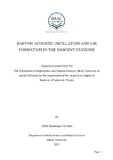| dc.contributor.advisor | Momen, Arshad | |
| dc.contributor.author | Nabi, AOM Mushfeque Un | |
| dc.date.accessioned | 2018-01-25T08:33:55Z | |
| dc.date.available | 2018-01-25T08:33:55Z | |
| dc.date.copyright | 2017 | |
| dc.date.issued | 2017 | |
| dc.identifier.other | ID 06311002 | |
| dc.identifier.uri | http://hdl.handle.net/10361/9207 | |
| dc.description | This thesis is submitted in a partial fulfillment of the requirements for the degree of Bachelor of Science in Physics. | en_US |
| dc.description | Cataloged from PDF version of thesis. | |
| dc.description | Includes bibliographical references (page 53). | |
| dc.description.abstract | The Cosmic Microwave Background Radiation (CMBR) and cosmological redshift are together regarded as the best available evidence for the Big Bang theory. Measurements of this radiation have made the inflationary Big Bang theory the standard model of the primitive universe. These measurements are conducted by cosmic detectors sent by astronomers into space (via satellites). The CMB consists of anisotropies (irregularities) which are present across the sky. The anisotropy of the CMB consists of the small temperature fluctuations in the blackbody left over from the Big Bang (average temperature 2.725K as measured by FIRAS on COBE). The fluctuations lie over a region known as the surface of last scattering, where the CMB photons were scattered for the last time before being detected. The anisotropy of the cosmic microwave background is divided as:
1. Primary anisotropy, (due to effects which occur at the last scattering surface and before)
2. Secondary anisotropy (due to effects such as interactions of the background radiation with hot gas or gravitational potentials, which occur between the last scattering surface and the observer)
The structure of the cosmic microwave anisotropies is principally determined by two effects: acoustic oscillations and diffusion damping. In the first part of the thesis a description of the primary anisotropy of the CMBR will be detailed. Data analysis and mathematical derivations will be cited in the second part where the relevant power spectra and diffusion damping oscillation graphs will be shown. Finally, the results based on seven years of data from the Wilkinson Microwave Anisotropy Probe (WMAP) shall be presented and any theories regarding future research will be stated. | en_US |
| dc.description.statementofresponsibility | AOM Mushfeque Un Nabi | |
| dc.format.extent | 53 pages | |
| dc.language.iso | en | en_US |
| dc.publisher | BRAC University | en_US |
| dc.rights | BRAC University thesis reports are protected by copyright. They may be viewed from this source for any purpose, but reproduction or distribution in any format is prohibited without written permission. | |
| dc.subject | Baryons | en_US |
| dc.subject | Scalar field theory | en_US |
| dc.title | Baryon acoustic oscillation and LSS formation in the nascent universe | en_US |
| dc.type | Thesis | en_US |
| dc.contributor.department | Department of Mathematics and Natural Sciences, BRAC University | |
| dc.description.degree | B. Science in Physics | |

